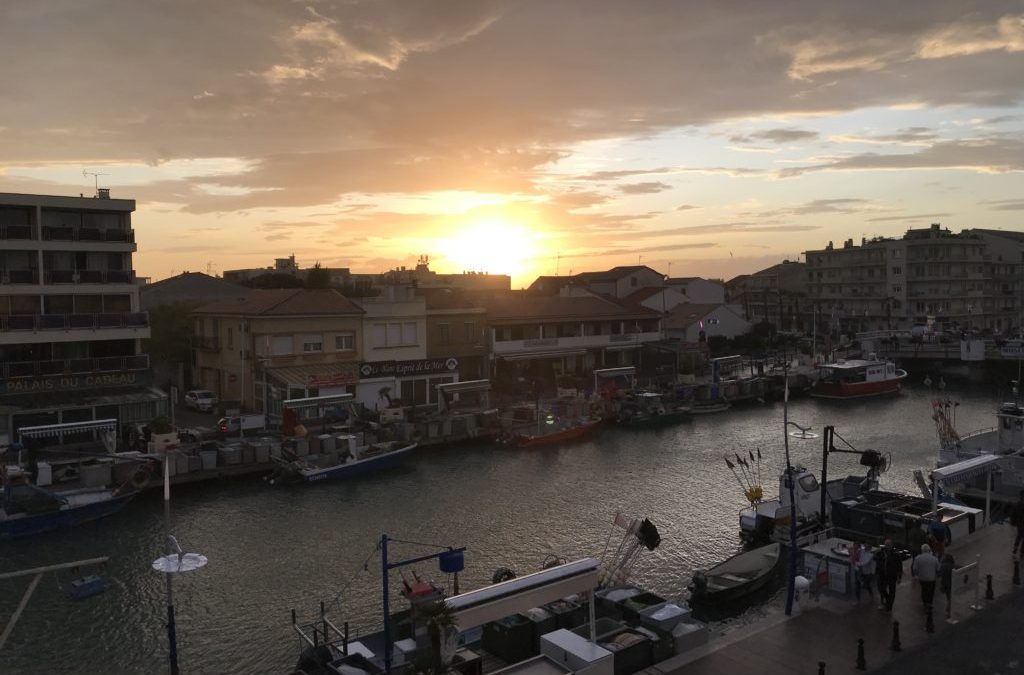
Oct 26, 2019
We knew we couldn’t avoid rainy weather for seven weeks, yet we had an astoundingly good run of sunny, warm days right until our final week. After leaving St. Remy de Provence after a week there, we drove to Palavas-les-Flots, a beach resort town about a 15-minute drive from Montpellier. Our new apartment was right over the canal there, so we could see people coming and going, fishermen selling their wares, cyclists and some pretty impressive thunder and lightning, or orages and éclats.
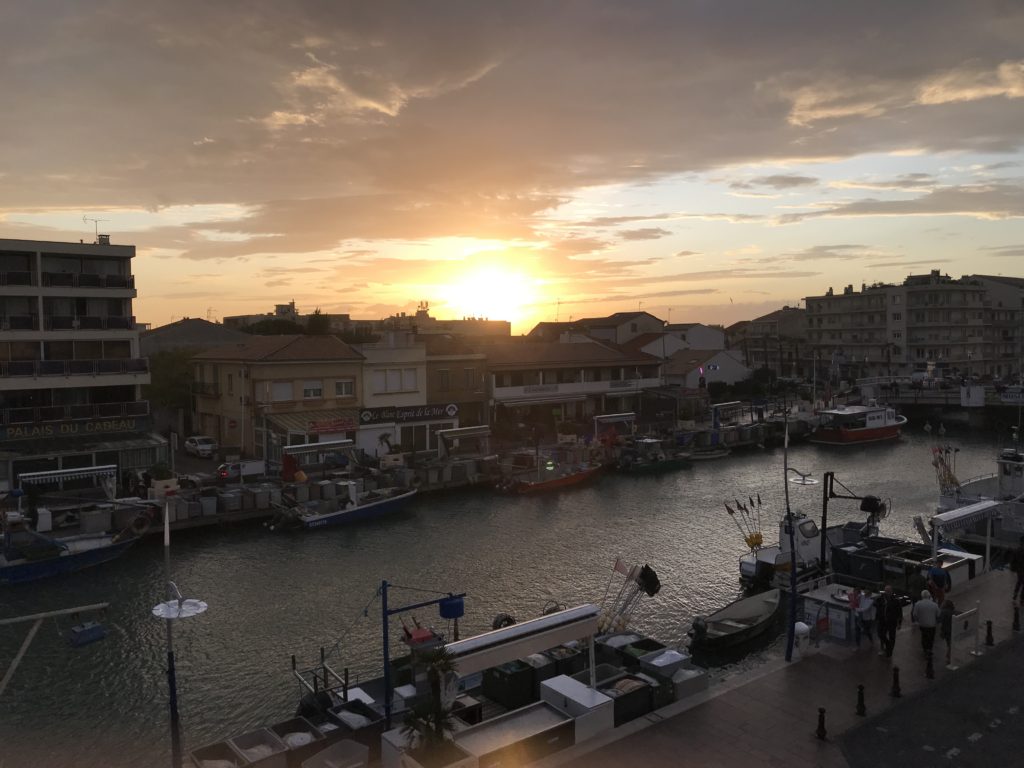
View from our balcony in Palavas les Flots.
We stil walked around cloudy Pavalas (a faded starlet kind of beach town, which I liked) and found lots to do: an aquarium in nearby Grau de Roi, nature trails, a museum devoted to cartoonist and artist Albert Dubout, a museum featuring the old train that ran for decades from Pavalas (originally a fishing village) to larger Montpellier.
Some pretty serious weather blew in and we watched the incredible light show from the stage of our upper-floor apartment. My favourite thing bout Pavalas, hands down, was the dozens of flamants rose, or pink flamingos. Briar and I have been running together and seeing them was a highlight. The birds were so exquisite: cotton candy feathers with fuchsia-dipped wings.
Unfortunately, the rain kept coming and turned into full-on flood for the area. We became very concerned about driving to return our rental car in Montpellier and catch a train to Barcelona. While we made it to Montpellier without finding roads washed out, we discovered that many trains were delayed or cancelled. Then the rain became truly biblical, coming down in sheets punctuated by epic flashes of lighting and claps of thunder. The train station started flooding. This Mediterranean deluge brought four months’ of rain to the area in a single day! We know rain, but this was incredible. Unfortunately, lives were lost during the deluge, which affected Italy, France and Spain.
We spent the day trying to figure out what was happening, what to do about it, and speaking not-great French. In the end, all trains to Barcelona and a few other destinations were cancelled that day and the next. In fact, no trains will run to Barcelona until November because tracks are under water. The train was out.
Le gare became chaotic with the flooding and distressed people crying. Fortunately, our children were basically glued to their devices doing homework and not concerned. We bought them Nutella pancakes, so they were not exactly suffering during the delay. Nutella is like a shared religion in the EU, which is fine with A.J. He could bathe in the stuff.
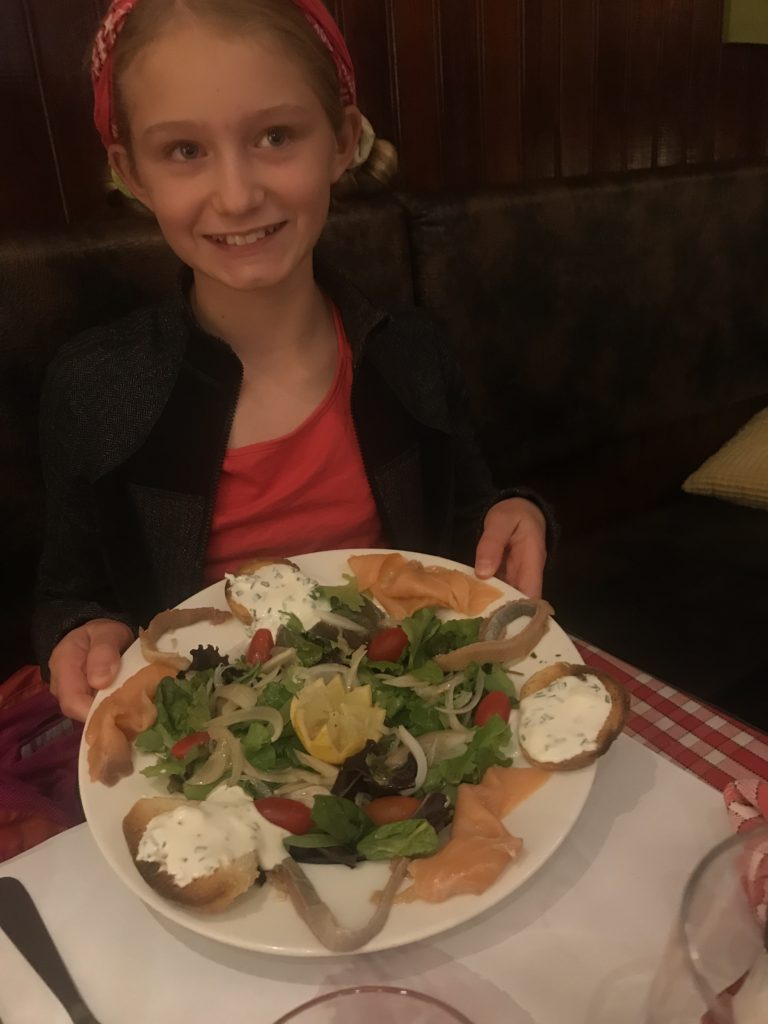
Briar ordered a salad with smoked salmon for our last dinner in France.
But anyway, we called a modern (and not cheap) hotel, Golden Tulip, that was three minutes’ away and we literally ran there with our suitcases. We still got drenched as if by sprayed by a fire hose. The kids were delighted to be a hotel room. We were not excited to pay for accommodation in both Montpellier and Barcelona that night, but we were safe and dry, so felt fortunate. We ended up going back and forth to the station for updates, eventually a refund, and trying to figure out if bus travel was feasible and safe. We fly home from Barcelona, so we had to get there somehow.
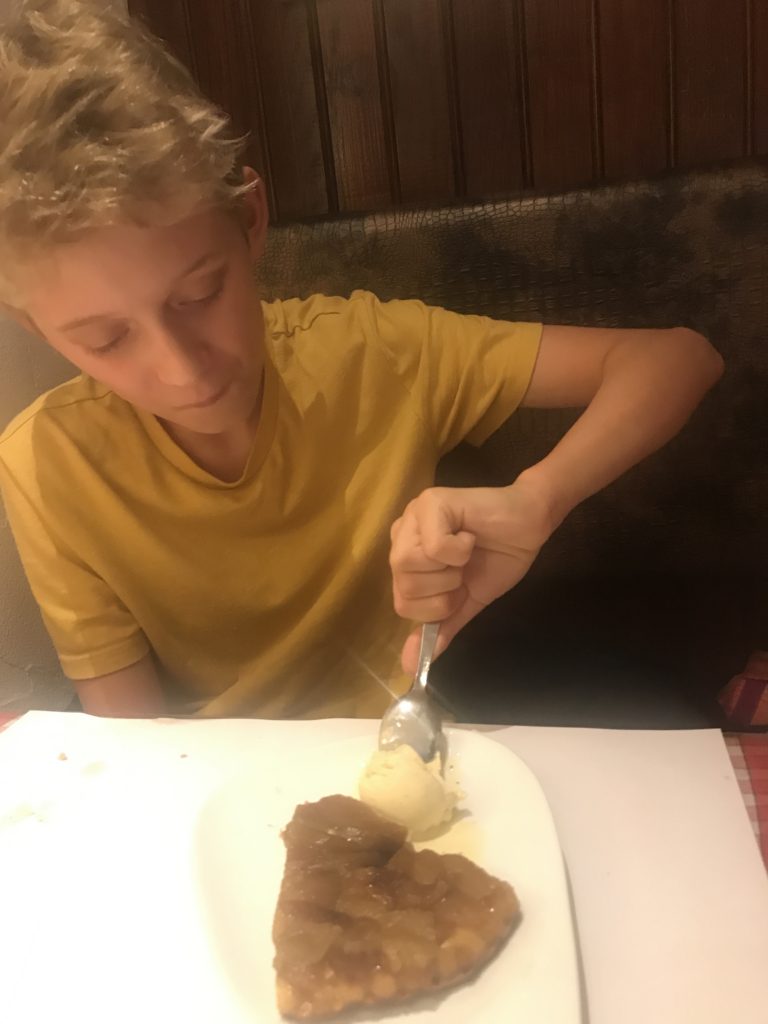
A.J. digs into tarte tatin.
Once the rain let up (several hours later) we walked around Montpellier, and bought two styles of macarons from two different places—one the kind of colourful jewels made with cream (pinks and greens and corals) and one organic and homey. We later ventured out to dinner, after feuding about where to go, only to find the one restaurant we agreed on was closed. We randomly chose a place called Le Tomate, which had inventive, delicious food. I had herring as an entrée (appetizer in France). It was served on sliced potatoes with carrot medallions and sautéed onion. It was so simple and tasty. David was determined to make his meal as French as possible, and even had frogs’ legs. For dessert, we all attacked (like group hunters with spears) two traditional desserts: tarte tatin and Dame Blanche, which was a bowl of cream, almonds, ice cream and warmed chocolate. The day ended well for us, and it was nice to see more of Montpellier, with its cobblestone streets and ironwork—but the experience was frightening. Sadly, we later learned that some people in affected communities were swept away by the waters and perished.
The next day, we took a bright green low-budget Flixbus to Barcelona, where the sun was shining. As we entered the city, we could see many Catalan flags hanging in windows and yellow ribbons in support of jailed Catalan independence leaders. A few days earlier, half a million people had marched to protest the long sentences given to Catalan independence leaders and there had been much unrest.

Sagrada Familia outside.
We are staying in L’Hospitalet de Llobregat, a densely populated municipality of Barcelona, in a stylish apartment on the fourth floor. The current political situation is on our minds, but yesterday we travelled by subway to see Gaudi’s Sagrada Familia, a basilica so unusual, towering and perfect that my eyes filled with tears as I looked around, bathed in the coloured light from the stained glass. A week earlier, the Sagrada had been blocked by protestors, but all was peaceful that day. From there, we walked to see Gaudi’s Parc Guëll, a public green space that was originally intended to be a housing developing for the wealthy.
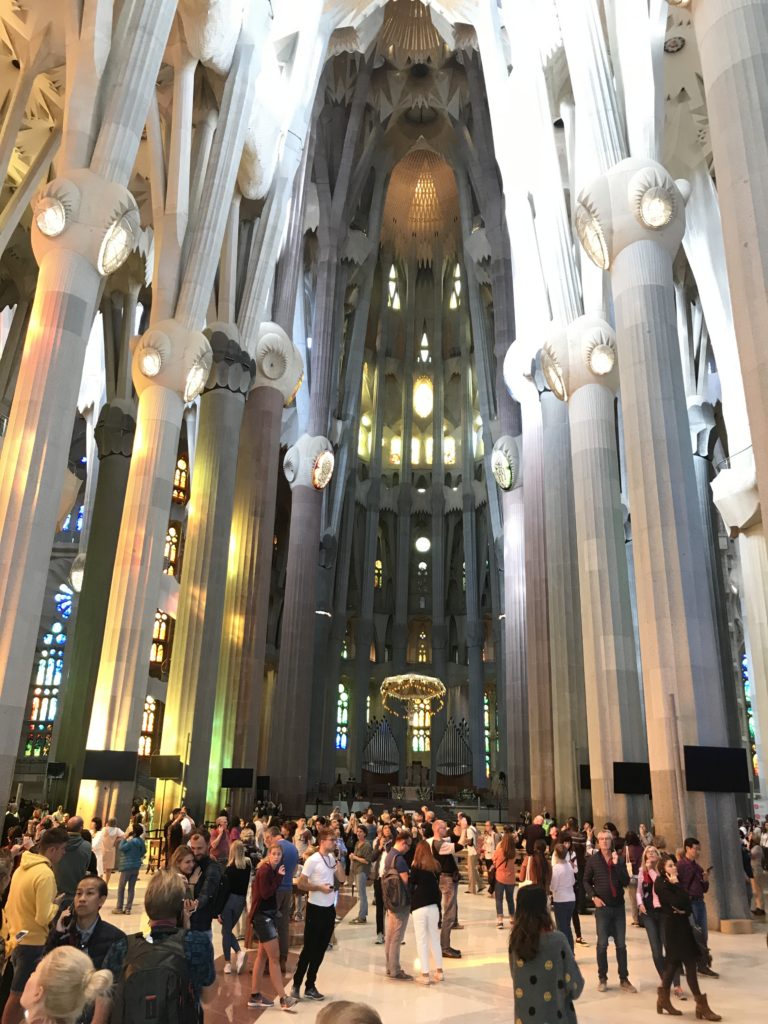
The stunning basilica inside. It will be completed in 2026.
We spent six hours walking around and enjoying the sunshine. I admit that I did not know much about Gaudi, but found his work so intriguing. I have learned so much on this trip about politics, culture, art, architecture and even macarons. On that note, the second macaron shop in Montpellier we visited was family run and focused on traditional Provencal baking. The owner was there with his young daughter. He had lived in Vancouver, loved Vancouver Island, and said he had two favourite mountains in the world, one was in the Pyrenees and the other was Mount Baker, the peak we see everyday in Victoria, at home.

Oct 16, 2019
We are now in our third stop in France. Our visit began with a brief visit to sunny, stylish Nice. We tried two delicious local foods in Nice: socca, a chickpea pancake, and Pissaladière, a type of Provençal open tart resembling pizza that usually includes onion, anchovies, and/or olives. We then spent three nights in Cassis, a picturesque seaside town where we hiked the Calanques, narrow steep-walled inlets. Our somewhat challenging and rewarding trek ended included a frigid swim in breathtakingly clear Mediterranean waters.
It is interesting being able to communicate more effectively. Locals speak to me and I realize that I can understand them—albeit it takes me a moment or two. I found yesterday that I was wondering “what is that bruit?” Words are coming back covered in cobwebs: voisin, propre, brosse, tapis, gaspillage, usine. My accent is fairly tragic, but we are no longer in places where English is widely spoken, so people are not switching when I use French.
We are now in Saint-Rémy-de-Provence, and there is much to do here, though we are all winding down somewhat, missing friends and family and weary of the packing and unpacking. On our first full day here we walked to Glanum, a local archaeological site founded by the Gauls, then a Hellenistic period and finally the Romans. It is enjoyable to roam around en plein aire.

Statue at St. Paul de Mausole by Gabriel Sterk.
Yesterday, we visited the Saint Paul de Mausole, the Romanesque monastery where Vincent Van Gogh spent a year of his life as a psychiatric patient and produced an astonishing number of works while there, including The Starry Night. The institution still serves local residents and provides programs to help them make art—I was tempted to buy some that was on display.
I was surprised to learn that Van Gogh sold only one painting during his lifetime. I was feeling wistful, and it made me sad to consider how much more content and stable he perhaps could have been had he benefitted from modern pharmaceuticals. St. Paul’s sounded (and, to be honest, made themselves sound) fairly progressive for https://davidleach.ca/wp-admin/media-new.phpVan Gogh’s times though they still used therapies that are horrifying today, such as forced feeding and regimes of hot and cold baths.
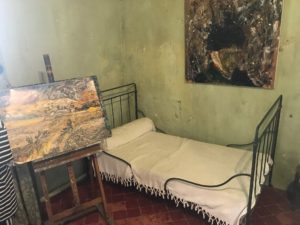
It was moving to stand in Van Gogh’s former bedroom, look out the window and see those colours and the landscape—the golden yellows, the olive trees, the wheat, the hills—that inspired his greatest works. As we walked back to town, I mentioned to A.J. and Briar that I hoped the stigma of mental illness is successfully reduced during their lifetime. We are far from there yet.
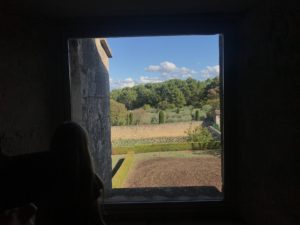
View from Van Gogh’s bedroom window.
Moving on to lighten the mood of this blog: we have an outdoor ping-pong table at our AirBnB. The condo is spacious and pleasant—especially after the cramped quarters in Cassis, where we occupied a tiny, eccentric main floor space between two restaurants.
Ping-pong remains the one game involving hand-eye coordination that I can actually play. I am not allowed to reveal the details of which individuals I may have beaten in ping-pong combat. The property also has an outdoor pool, walnut trees and fragrant flowers and shrubs that attract a very strange moth-hummingbird, a creature new to me. It looks just like a tiny hummingbird, but is technically an insect. Very étrange!
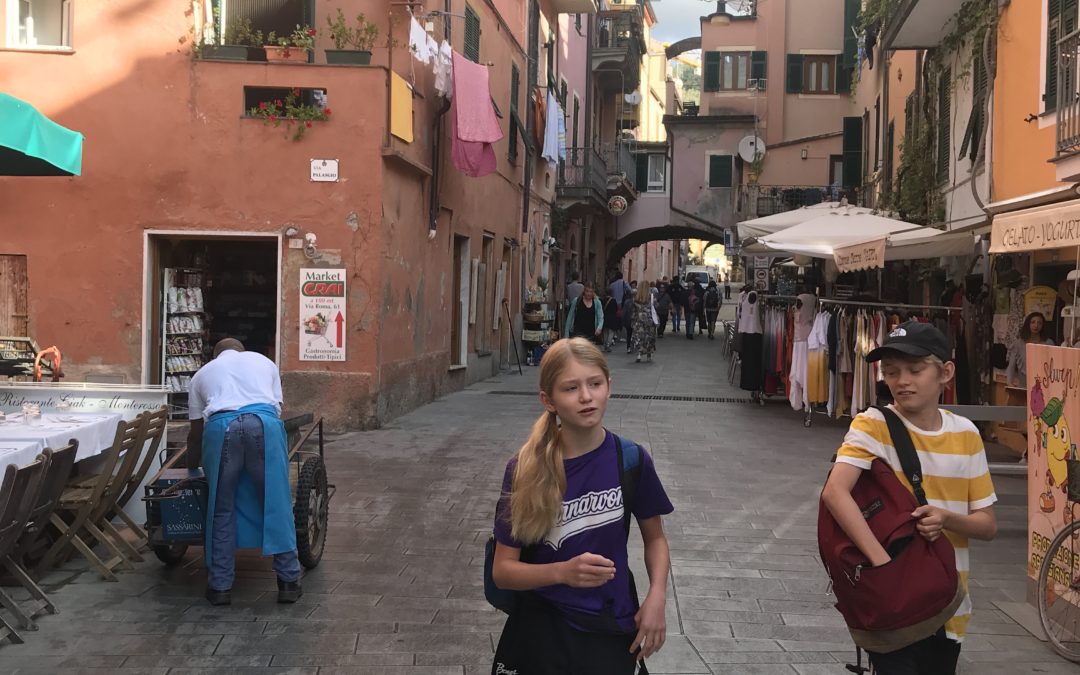
Oct 8, 2019
After three days in Cinque Terre staying in the seaside village of Monterosso, we are currently on a train bound for Nice. Monterosso and the other famous villages were scenic and interesting but also very crowded, even in October. My favourite time was spent hiking from Monterosso to the nearby town of Levanto. It was hot, uphill hiking, with a stop to view an ancient sanctuary at Punto Mesco. Luckily, Levanto (not one of the five villages) had a beach to make the kids happy after their hours of hiking.
I am sad to be leaving Italia, particularly as I have now mastered making espresso in a Mokapot. A.J. has become a self-taught expert in this and did considerable research about the best technique. He even bought himself a pack of espresso decaf. We are eating most meals in our AirBnB apartments—so far lots of pasta, beans and salad served with olive oil and balsamic vinegar), and out for an occasional dinner in a a restaurant. In Monterossi, we had pizza on an outdoor patio by the beach. The area is home to pesto, so we also bought a jar to try. Briar is a pesto maniac.
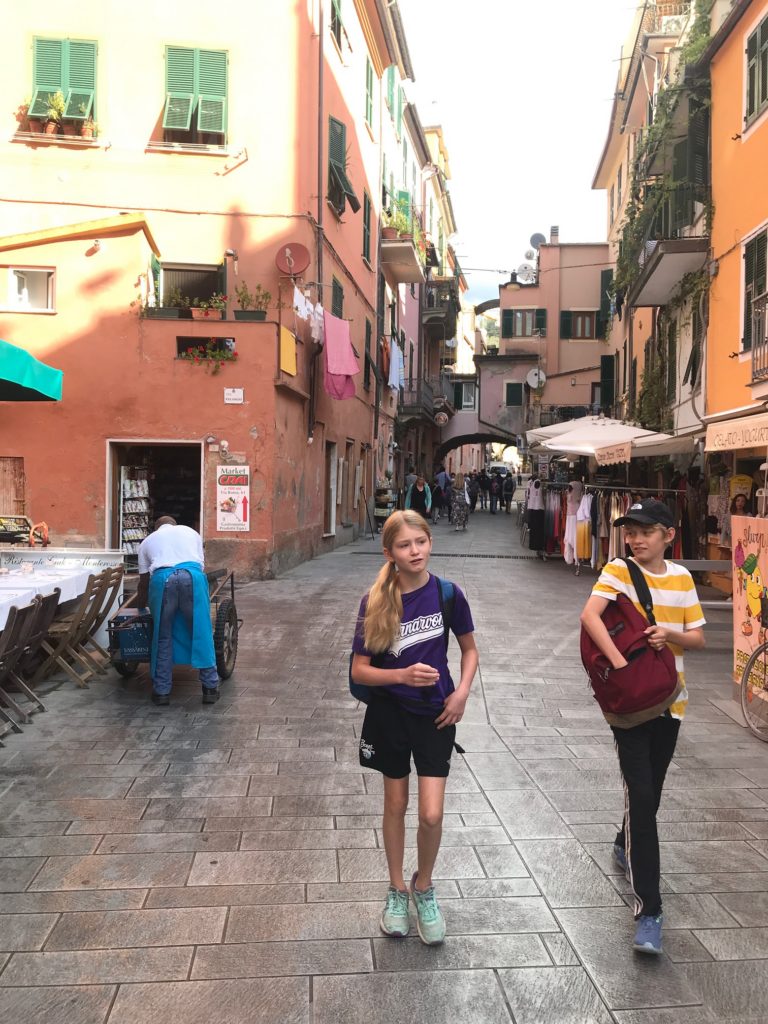
Street scene in Monterosso. Green shutters and laundry hanging.
Some things that will remind me of Italia:
- Mokapots. Every apartment we stayed in had one. Otherwise, there has been a real range of kitchen tools. One place had a panini press and a mezzaluna but no spatula or turner.
- Seeing people enjoy Aperol spritzes on patios. The spritzes are served in bulb-like glasses with a lemon slice and a straw. Aperol seems similar to Campari in flavour.
- Laundry hanging on balconies, everywhere, everyday. Sheets might be dangling right over people eating dinner in a ristorante. I respect that! All our apartments have had one small washing machine, usually a Candy model.
- Ochre buildings with green shutters.
- Apricots growing on vines over fences. Lemon trees.
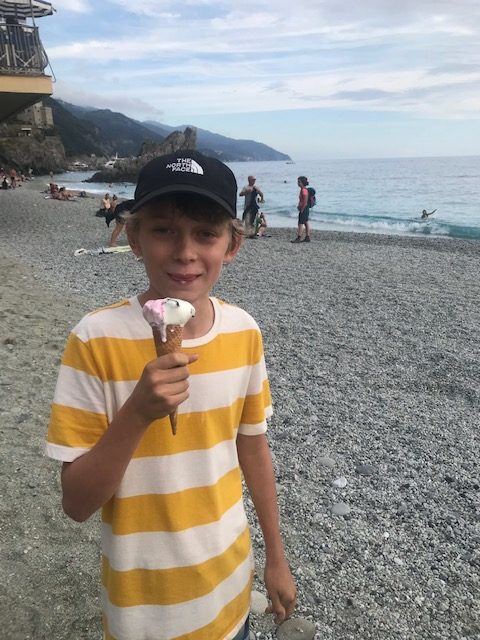
A.J. with a cone. He had two gelatos on our last day.
A few things I will miss:
- Bottles of Italian milk. Even partially skimmed (scremato) it is inexpensive (to me) and delicious. This trip has actually made me realize how expensive food is on Vancouver Island as we have been shopping in some busy tourist areas and I have not been shocked by prices.
- Peaches from Sicily. All fruit has been delicious.
- Focaccia. I am not even the biggest fan (Briar again!) but it was particularly good in Monterosso. We shared some on the train.
- Gelato, a thousand times gelato. A.J. obsessed over it. His favourite was stracciatella, a traditional flavour with chocolate chip pieces. The names are beautiful. Last night I tried fior di latte (flower of milk).
- I will also miss seeing so many ancient buildings and places. Even the “barn” we stayed in in Tuscany was a thousand years old. The kids know well by now that I love ruins and exploring them. On my last night in Italy, I took a walk by myself along a stream lined by old lime mortar walls that lead to la Valle dei Limoni, the valley of lemons.
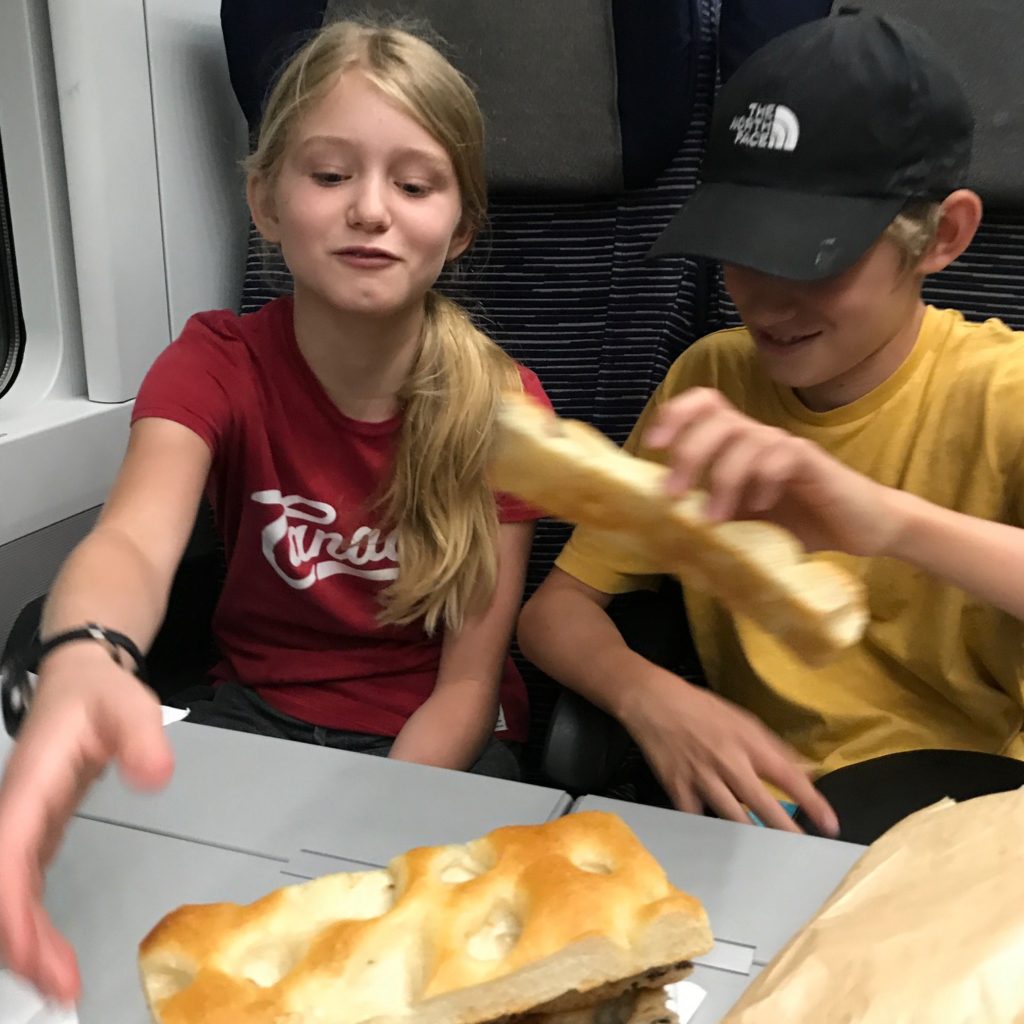
The last focaccia from Italy is unwrapped on the train.
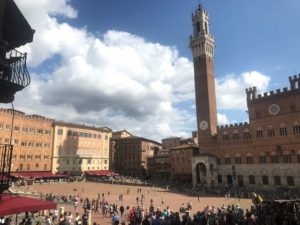
Oct 3, 2019
I had never imagined that Briar would be obsessed with wild boars. But she was. We stayed six nights on an olive farm near Montegonzi, Tuscany, home to black scorpions and wild boars. There was olive oil to sample, a pool surrounded by olive trees and three dogs on site—including a sleepy-eyed lumbering Newfoundland named Nelson. We were a 25-minute drive from any store, but close to winding roads, rolling hills, medieval castles and many vineyards and olive farms.

The famous Siena square.
The highlight of the kids’ stay in Tuscany will surely be the Tuscany cooking class they attended in a rural farm or podere, along with their dad and a couple from New York. I chose to roam the hillsides, visiting a convent, walking past tiny chapels and shrines and watching grapes being harvested for the famous Chianti wine.
We returned to busy streets for a day trip to Siena, with its most beautiful medieval square, the Piazza del Campo. We toured their ancient hospital that cared for the poor and abandoned—Santa Maria Della Scala, which was a captivating combination of high art in frescos and bizarre underground tunnels with bones and artefacts.
Briar never did see a wild boar while we were in Tuscany, though she heard their howling guttural sounds at night—which incensed the dogs. She will have to return some day.

A shrine by the roadside in Tuscany.
From Montegonzi we drove to Piombino and took an hour-long ferry ride to Rio Marina and then Porto Azzurro on Elba Island on the Tyrrhenian Sea. It is apparently chock-a-block with tourists in July and August, but the ferry ride over had the air of an empty Carnival cruise ship. Porto Azzurro was not empty—there were quite a few German families, particularly in the campgrounds—but overall the village of 3,700 or so residents was peaceful and welcoming in its shoulder season.
I had two particularly wonderful runs, one along a coastline trail that took me past three beaches: Barbarossa, Reale, and Terranera. Elba is known for its beautiful beaches, but there was more here, for example a Spanish fortress, now a prison, that looms over the cliffs, and minerals—evident in the sparkling black sand of Terranera. Elba’s mining history apparently dates back to the Etruscans, one of many peoples who took turns ruling and living on Elba.
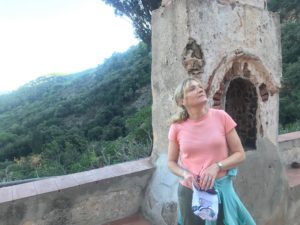
Standing at the sanctuary.
Another run took me to Spiaggia di Barbarossa then up a long, winding road to a pine tree called the pino monumentale, or nonno (grandfather) pino, said to be 400 years old. From there I ran to a hidden cliff top sanctuary, the Sanctuario della Madonna di Monserrato. The stone church in the cliffs was commissioned in 1606 by the Spanish governor Pons y Léon to worship the cult of the Black Madonna (in Spain worshipped at the Montserrat Sanctuary). I found myself completely alone on the path and at the top. The chapel door was locked, but the view of the ocean, the town below, and the strange, otherworldly stone chapel was eerie and exhilarating.

The painting of the Black Madonna seen in the sanctuary.
David and I later hiked to the sanctuary another afternoon. The chapel was again closed, but we peeped through the keyhole to glimpse the altar with the painting of the Madonna. Taking the path down to real life, we agreed we had seen something unusual and special.
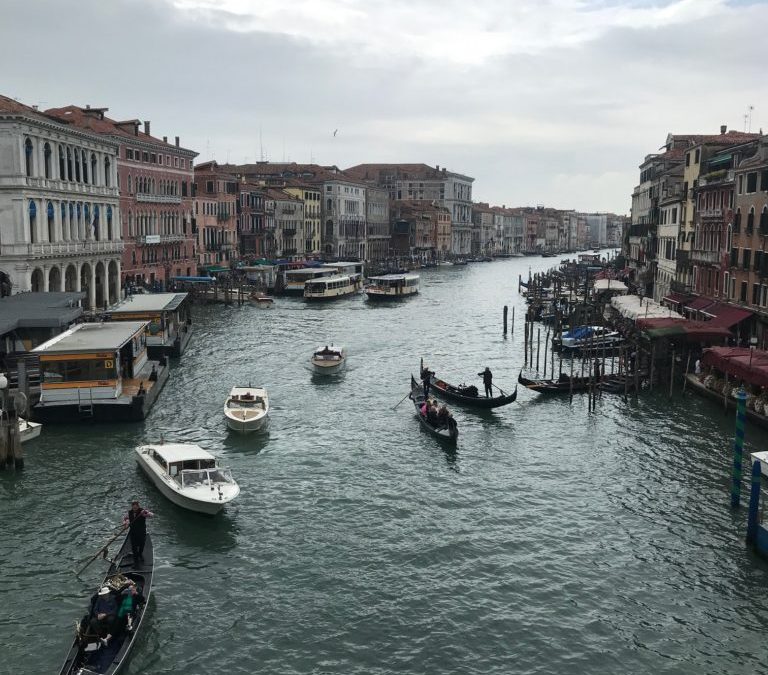
Sep 27, 2019
We set out to Venice by train from Bologna early in the morning, only to be delayed by 25 minutes at the station. After a café macchiato while we waited, we eventually boarded and by the time we arrived in Venice, the rain was sluicing down the train windows. On the steps of the station, vendors were doing a swift business in selling brightly coloured ponchos. For once, I felt my chronic underdressing in Italy had paid off—I was wearing hiking pants, a Mountain Hardwear jacket and a Blue Jays cap. I was ready for this pioggia.
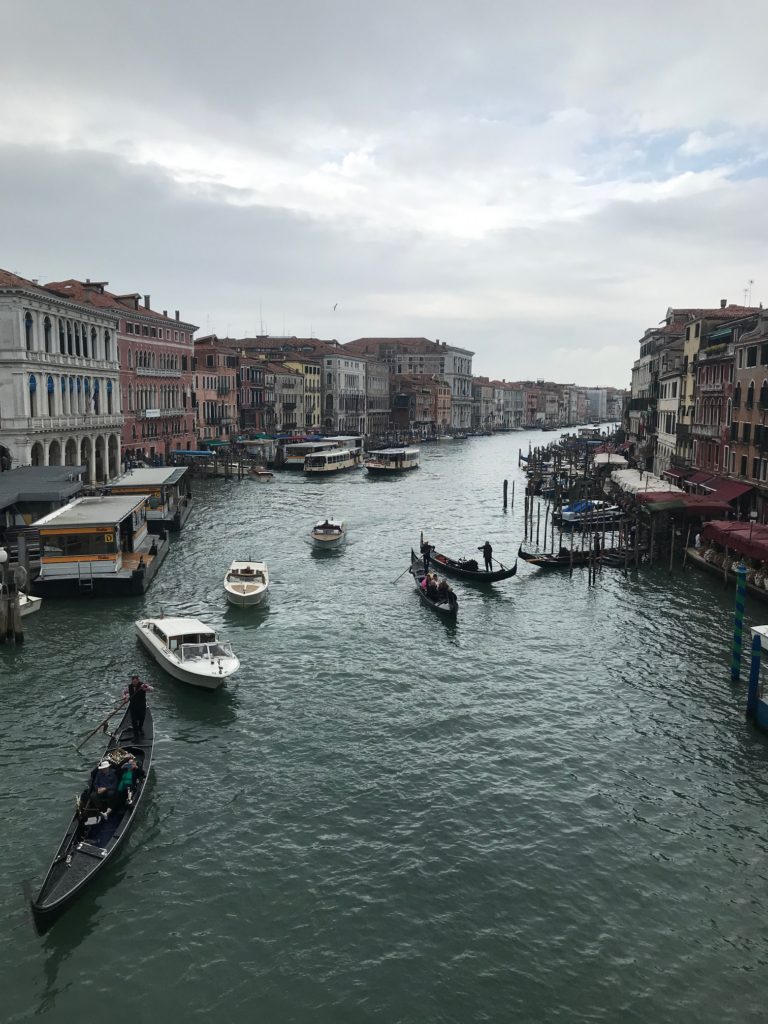
Venice views.
We had seven hours to spend in a very rainy Venice and chose to start out in the less populated Canareggio area, which includes the old Jewish ghetto. There was almost no one there, and it was possible to walk the streets and imagine what was like centuries ago, before cruise ships and jet planes. The Venetian Jewish ghetto was formed in 1516, the first in the world. Jews were confined to the area by night and forced to wear red caps during the day to identify them. A.J.’s class in school is studying Shakespeare, so we have been applying what we saw in Venice to the story of Merchant of Venice.
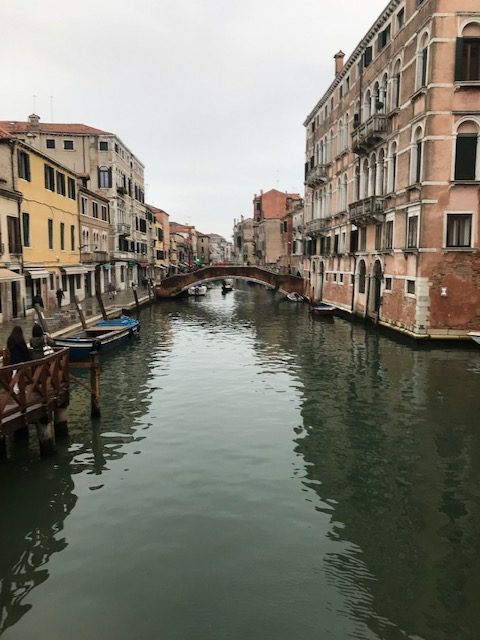
The Canareggio neighbourhood in Venice.
My favourite part of Venice is the calles, the narrow streets. It seems there is a story behind every one. The Venetian republic forced landowners to leave a small distance between buildings— apparently how Venice ended up with this maze of fascinating calles.
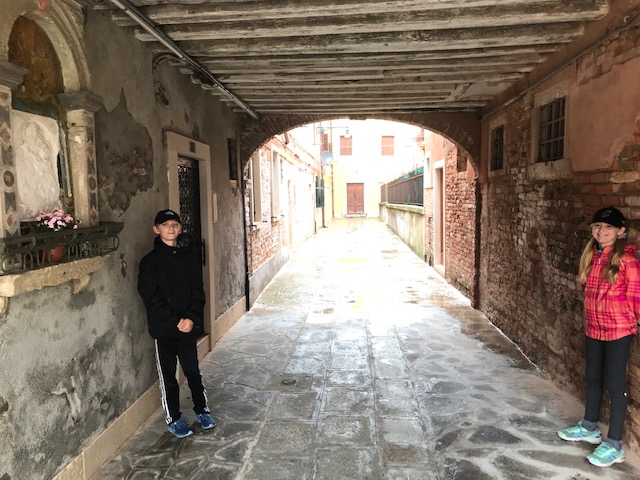
One of the many calles.
There are surely a million stories in Venice. I was overwhelmed the number of ancient, evocative buildings and bridges. There are also a million tourists in Venice, which we felt when we made our way to Piazza San Marco. There were throngs of tourists and massive groups of cruise ship passengers being herded and counted.
Briar must be growing, because she could have eaten the entire Veneto region. We threw her apple slices, mini paninis, peanuts and granola bars, and readers, she remained in the Republic of Hangry. But, we still managed to get in a tour of the Palazzo Ducale, or Doge’s Palace. A special exhibition on Rubens was on, which we toured along with vast, lavishly decorated rooms dedicated to justice and political affairs of the Doge, the leader. The sights included armour and, my favourite, the ancient prisons. I loved the room showing slabs of graffito from the prison walls.
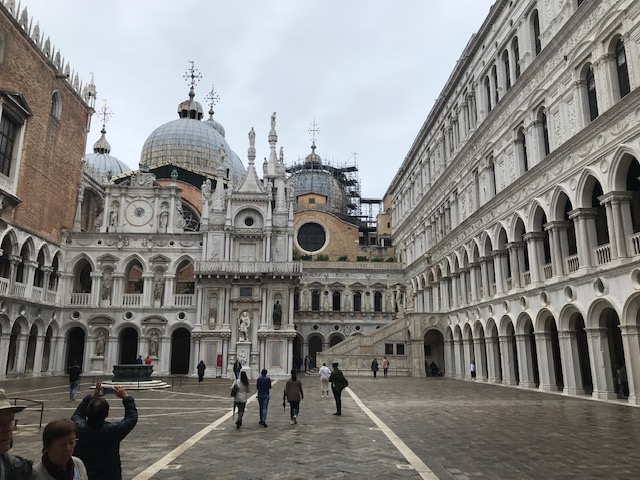
The Doge’s Palace courtyard.
Along with the Doge, we also visited a modern and interesting exhibit called Personal Structures: Open Borders at the European Cultural Centre in the Palazzo Mora as part of la Biennale di Venezia. Some of the art was perhaps not so appropriate for kids, but they did have a toilet, so it evened out.
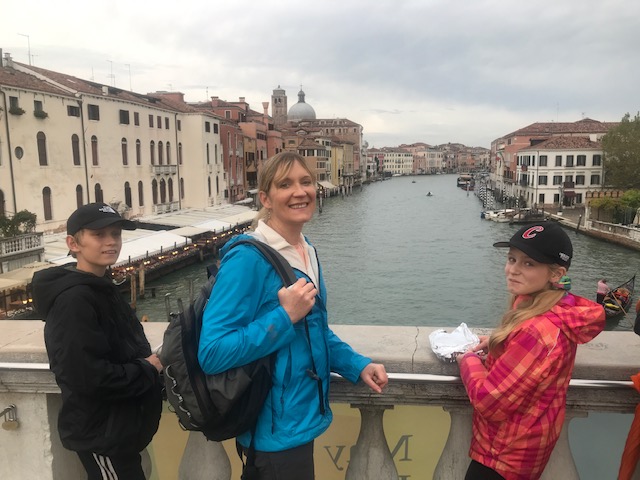
A last view before the train ride to Bologna.
Briar refused to continue without more food, so we found a café and ordered her a huge cheese pizza so she didn’t eat us on the train ride back to Bologna. A.J. chose a pizza covered with French fries on top, something only a 13-year-old boy could consume. Thanks to the free art exhibit, the restaurant, and the Doge visit, we spent seven hours in Venice (with Briar!) without spending any Euros on public toilets. Sorprendente!






















